Deck 16: Interest Rates and Monetary Policy
Question
Question
Question
Question
Question
Question
Question
Question
Question
Question
Question
Question
Question
Question
Question
Question
Question
Question
Question
Question
Question
Question
Question
Question
Question
Question
Question
Question
Question
Question
Question
Question
Question
Question
Question
Question
Question
Question
Question
Question
Question
Question
Question
Question
Question
Question
Question
Question
Question
Question
Question
Question
Question
Question
Question
Question
Question
Question
Question
Question
Question
Question
Question
Question
Question
Question
Question
Question
Question
Question
Question
Question
Question
Question
Question
Question
Question
Question
Question
Question

Unlock Deck
Sign up to unlock the cards in this deck!
Unlock Deck
Unlock Deck
1/174
Play
Full screen (f)
Deck 16: Interest Rates and Monetary Policy
1
If nominal GDP is $800 billion and, on average, each dollar is spent four times in the economy over a year, then the quantity of money demanded for transactions purposes will be:
A) $200 billion
B) $400 billion
C) $800 billion
D) $3,200 billion
A) $200 billion
B) $400 billion
C) $800 billion
D) $3,200 billion
$200 billion
2
A decrease in the interest rate will cause a(n):
A) Increase in the transactions demand for money
B) Decrease in the transactions demand for money
C) Decrease in the amount of money held as an asset
D) Increase in the amount of money held as an asset
A) Increase in the transactions demand for money
B) Decrease in the transactions demand for money
C) Decrease in the amount of money held as an asset
D) Increase in the amount of money held as an asset
Increase in the amount of money held as an asset
3
A consumer holds money to meet spending needs. This would be an example of the:
A) Use of money as a measure of value
B) Use of money as legal tender
C) Transactions demand for money
D) Asset demand for money
A) Use of money as a measure of value
B) Use of money as legal tender
C) Transactions demand for money
D) Asset demand for money
Transactions demand for money
4
The transactions demand for money will shift to the:
A) Left when nominal GDP increases
B) Left when nominal GDP decreases
C) Right when nominal GDP decreases
D) Right when the interest rate increases
A) Left when nominal GDP increases
B) Left when nominal GDP decreases
C) Right when nominal GDP decreases
D) Right when the interest rate increases

Unlock Deck
Unlock for access to all 174 flashcards in this deck.
Unlock Deck
k this deck
5
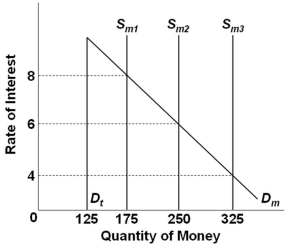 Refer to the graph above, in which Dt is the transactions demand for money, Dm is the total demand for money, and Sm is the supply of money. The market is in equilibrium at the 6 percent rate of interest. If the money supply then decreases as shown, the transaction demand for money will change by:
Refer to the graph above, in which Dt is the transactions demand for money, Dm is the total demand for money, and Sm is the supply of money. The market is in equilibrium at the 6 percent rate of interest. If the money supply then decreases as shown, the transaction demand for money will change by:A) $175
B) $125
C) $75
D) $0

Unlock Deck
Unlock for access to all 174 flashcards in this deck.
Unlock Deck
k this deck
6
If nominal GDP is $4,000 billion and the amount of money demanded for transactions purposes is $800 billion, it can generally be concluded that:
A) The asset demand for money is $3,200 billion
B) The total demand for money is $4,800 billion
C) On average, each dollar will be spent five times a year
D) The supply of money needs to be increased to meet the demand
A) The asset demand for money is $3,200 billion
B) The total demand for money is $4,800 billion
C) On average, each dollar will be spent five times a year
D) The supply of money needs to be increased to meet the demand

Unlock Deck
Unlock for access to all 174 flashcards in this deck.
Unlock Deck
k this deck
7
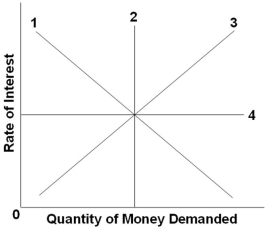 Which line in the graph above would best illustrate the transactions demand for money curve?
Which line in the graph above would best illustrate the transactions demand for money curve?A) Line 1
B) Line 2
C) Line 3
D) Line 4

Unlock Deck
Unlock for access to all 174 flashcards in this deck.
Unlock Deck
k this deck
8
If the dollars held for transactions purposes are, on the average, spent four times a year for final goods and services, then the quantity of money people will wish to hold for transactions purposes is equal to:
A) Four percent of nominal GDP
B) 25 percent of nominal GDP
C) Nominal GDP multiplied times 4
D) Nominal GDP divided by 25
A) Four percent of nominal GDP
B) 25 percent of nominal GDP
C) Nominal GDP multiplied times 4
D) Nominal GDP divided by 25

Unlock Deck
Unlock for access to all 174 flashcards in this deck.
Unlock Deck
k this deck
9
 Refer to the table above. Suppose that the transactions demand for money is $300 billion and the money supply is $700 billion. A decrease in the money supply to $600 billion would cause the interest rate to:
Refer to the table above. Suppose that the transactions demand for money is $300 billion and the money supply is $700 billion. A decrease in the money supply to $600 billion would cause the interest rate to:A) Rise to 7 percent
B) Rise to 6 percent
C) Fall to 4 percent
D) Fall to 5 percent

Unlock Deck
Unlock for access to all 174 flashcards in this deck.
Unlock Deck
k this deck
10
Which of the following varies directly with the interest rate?
A) The opportunity cost of holding money
B) The transactions demand for money
C) The asset demand for money
D) The level of investment
A) The opportunity cost of holding money
B) The transactions demand for money
C) The asset demand for money
D) The level of investment

Unlock Deck
Unlock for access to all 174 flashcards in this deck.
Unlock Deck
k this deck
11
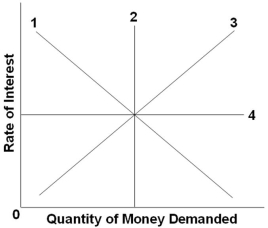 Which line in the graph above would best illustrate the supply of money curve?
Which line in the graph above would best illustrate the supply of money curve?A) Line 4
B) Line 3
C) Line 2
D) Line 1

Unlock Deck
Unlock for access to all 174 flashcards in this deck.
Unlock Deck
k this deck
12
An increase in nominal GDP will:
A) Increase the transactions demand and the total demand for money
B) Decrease the transactions demand and the total demand for money
C) Increase the transactions demand for money but decrease the total demand for money
D) Decrease the transactions demand for money but increase the total demand for money
A) Increase the transactions demand and the total demand for money
B) Decrease the transactions demand and the total demand for money
C) Increase the transactions demand for money but decrease the total demand for money
D) Decrease the transactions demand for money but increase the total demand for money

Unlock Deck
Unlock for access to all 174 flashcards in this deck.
Unlock Deck
k this deck
13
 Refer to the table above. Suppose that the transactions demand for money is equal to 20 percent of the nominal GDP, the supply of money is $800 billion, and the asset demand for money is that shown in the table. If the nominal GDP is $2000 billion, the equilibrium interest rate is:
Refer to the table above. Suppose that the transactions demand for money is equal to 20 percent of the nominal GDP, the supply of money is $800 billion, and the asset demand for money is that shown in the table. If the nominal GDP is $2000 billion, the equilibrium interest rate is:A) 4 percent
B) 5 percent
C) 6 percent
D) 7 percent

Unlock Deck
Unlock for access to all 174 flashcards in this deck.
Unlock Deck
k this deck
14
 Refer to the graph above, in which Dt is the transactions demand for money, Dm is the total demand for money, and Sm is the supply of money. The market is initially in equilibrium at a 6 percent interest rate. If the money supply increases, then Sm2 will shift to:
Refer to the graph above, in which Dt is the transactions demand for money, Dm is the total demand for money, and Sm is the supply of money. The market is initially in equilibrium at a 6 percent interest rate. If the money supply increases, then Sm2 will shift to:A) Sm3 and the interest rate will be 4 percent
B) Sm3 and the interest rate will be 8 percent
C) Sm1 and the interest rate will be 8 percent
D) Sm1 and the interest rate will be 4 percent

Unlock Deck
Unlock for access to all 174 flashcards in this deck.
Unlock Deck
k this deck
15
The transactions demand for money is least likely to be a function of the:
A) Price level
B) Interest rate
C) Level of national income
D) Frequency of wage and salary payments
A) Price level
B) Interest rate
C) Level of national income
D) Frequency of wage and salary payments

Unlock Deck
Unlock for access to all 174 flashcards in this deck.
Unlock Deck
k this deck
16
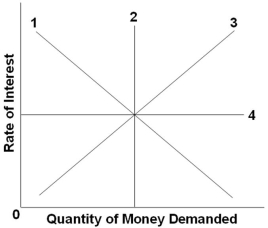 Which line in the graph above would best illustrate the asset demand for money curve?
Which line in the graph above would best illustrate the asset demand for money curve?A) Line 1
B) Line 2
C) Line 3
D) Line 4

Unlock Deck
Unlock for access to all 174 flashcards in this deck.
Unlock Deck
k this deck
17
There is an asset demand for money primarily because of which function of money?
A) Legal tender
B) Store of value
C) Measure of value
D) Medium of exchange
A) Legal tender
B) Store of value
C) Measure of value
D) Medium of exchange

Unlock Deck
Unlock for access to all 174 flashcards in this deck.
Unlock Deck
k this deck
18
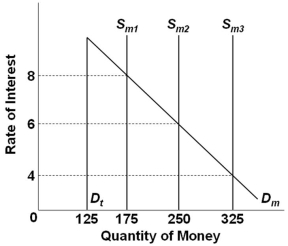 Refer to the graph above, in which Dt is the transactions demand for money, Dm is the total demand for money, and Sm is the supply of money. If the interest rate was 4 percent, the asset demand for money would be:
Refer to the graph above, in which Dt is the transactions demand for money, Dm is the total demand for money, and Sm is the supply of money. If the interest rate was 4 percent, the asset demand for money would be:A) $125
B) $175
C) $200
D) $225

Unlock Deck
Unlock for access to all 174 flashcards in this deck.
Unlock Deck
k this deck
19
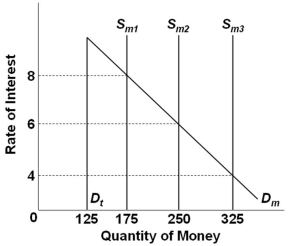 Refer to the graph above, in which Dt is the transactions demand for money, Dm is the total demand for money, and Sm is the supply of money. The market is initially in equilibrium at a 6 percent rate of interest. If the supply of money increases as shown, then the asset demand for money will increase by:
Refer to the graph above, in which Dt is the transactions demand for money, Dm is the total demand for money, and Sm is the supply of money. The market is initially in equilibrium at a 6 percent rate of interest. If the supply of money increases as shown, then the asset demand for money will increase by:A) $75
B) $125
C) $200
D) $325

Unlock Deck
Unlock for access to all 174 flashcards in this deck.
Unlock Deck
k this deck
20
A wealthy executive is holding money, waiting for a good time to invest in the stock market. This action would be an example of the:
A) Transactions demand for money
B) Asset demand for money
C) Creation of fiat money
D) Use of money as a medium of exchange
A) Transactions demand for money
B) Asset demand for money
C) Creation of fiat money
D) Use of money as a medium of exchange

Unlock Deck
Unlock for access to all 174 flashcards in this deck.
Unlock Deck
k this deck
21
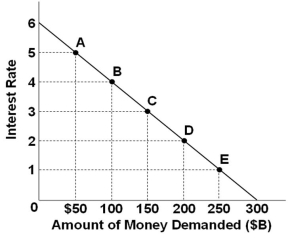 Refer to the graph above. If the interest rate rises from 2 percent to 3 percent, the supply of money must have:
Refer to the graph above. If the interest rate rises from 2 percent to 3 percent, the supply of money must have:A) Decreased by $50 billion
B) Decreased by $100 billion
C) Decreased by $150 billion
D) Increased by $50 billion

Unlock Deck
Unlock for access to all 174 flashcards in this deck.
Unlock Deck
k this deck
22
U.S. Treasury deposits at the Federal Reserve Banks are:
A) A liability of the Federal Reserve Banks and the U.S. Treasury
B) An asset of the Federal Reserve Banks and the U.S. Treasury
C) A liability of the Federal Reserve Banks and an asset for the U.S. Treasury
D) An asset of the Federal Reserve Banks and a liability for the U.S. Treasury
A) A liability of the Federal Reserve Banks and the U.S. Treasury
B) An asset of the Federal Reserve Banks and the U.S. Treasury
C) A liability of the Federal Reserve Banks and an asset for the U.S. Treasury
D) An asset of the Federal Reserve Banks and a liability for the U.S. Treasury

Unlock Deck
Unlock for access to all 174 flashcards in this deck.
Unlock Deck
k this deck
23
Loans of the Federal Reserve Banks to commercial banks are:
A) A liability of the Federal Reserve Banks and of the commercial banks
B) An asset of the Federal Reserve Banks and of the commercial banks
C) A liability of the Federal Reserve Banks and an asset for commercial banks
D) An asset of the Federal Reserve Banks and a liability for commercial banks
A) A liability of the Federal Reserve Banks and of the commercial banks
B) An asset of the Federal Reserve Banks and of the commercial banks
C) A liability of the Federal Reserve Banks and an asset for commercial banks
D) An asset of the Federal Reserve Banks and a liability for commercial banks

Unlock Deck
Unlock for access to all 174 flashcards in this deck.
Unlock Deck
k this deck
24
The interest rate will fall when the:
A) Quantity of money demanded exceeds the quantity of money supplied
B) Quantity of money supplied exceeds the quantity of money demanded
C) Demand for money increases
D) Supply of money decreases
A) Quantity of money demanded exceeds the quantity of money supplied
B) Quantity of money supplied exceeds the quantity of money demanded
C) Demand for money increases
D) Supply of money decreases

Unlock Deck
Unlock for access to all 174 flashcards in this deck.
Unlock Deck
k this deck
25
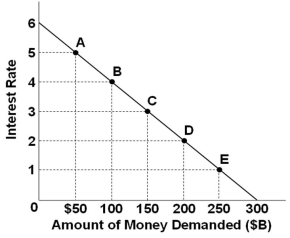 Refer to the graph above. If the equilibrium interest rate is 4 percent, the supply of money must be:
Refer to the graph above. If the equilibrium interest rate is 4 percent, the supply of money must be:A) $250 billion
B) $200 billion
C) $150 billion
D) $100 billion

Unlock Deck
Unlock for access to all 174 flashcards in this deck.
Unlock Deck
k this deck
26
An increase in the money supply is likely to reduce:
A) The general price level
B) Nominal income
C) Money demand
D) Interest rates
A) The general price level
B) Nominal income
C) Money demand
D) Interest rates

Unlock Deck
Unlock for access to all 174 flashcards in this deck.
Unlock Deck
k this deck
27
Which of the following statements is true?
A) Bond prices and the interest rate are inversely related
B) A lower interest rate raises the opportunity cost of holding money
C) The supply of money is directly related to the interest rate
D) The total demand for money is directly related to the interest rate
A) Bond prices and the interest rate are inversely related
B) A lower interest rate raises the opportunity cost of holding money
C) The supply of money is directly related to the interest rate
D) The total demand for money is directly related to the interest rate

Unlock Deck
Unlock for access to all 174 flashcards in this deck.
Unlock Deck
k this deck
28
If bond prices decrease, then the:
A) Interest rate decreases
B) Interest rate increases
C) Transactions demand for money will decrease
D) Transactions demand for money will increase
A) Interest rate decreases
B) Interest rate increases
C) Transactions demand for money will decrease
D) Transactions demand for money will increase

Unlock Deck
Unlock for access to all 174 flashcards in this deck.
Unlock Deck
k this deck
29
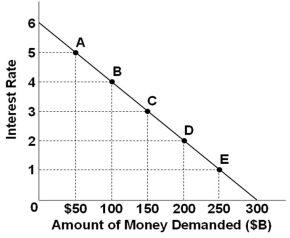 Refer to the graph above. If the initial equilibrium interest rate was 5 percent and the money supply increased by $100 billion, then the new interest rate would be:
Refer to the graph above. If the initial equilibrium interest rate was 5 percent and the money supply increased by $100 billion, then the new interest rate would be:A) 1 percent
B) 2 percent
C) 3 percent
D) 4 percent

Unlock Deck
Unlock for access to all 174 flashcards in this deck.
Unlock Deck
k this deck
30
A few years ago, you bought a bond with no expiration and a fixed annual interest payment of $1000 at a price of $10,000. If the interest rate in the economy is now 12.5% a year and you want to sell the bond, the maximum price that you can get for it is:
A) $7,500
B) $8,000
C) $9,750
D) $12,500
A) $7,500
B) $8,000
C) $9,750
D) $12,500

Unlock Deck
Unlock for access to all 174 flashcards in this deck.
Unlock Deck
k this deck
31
A bond with no expiration has an original price of $10,000 and a fixed annual interest payment of $1000. If the price of this bond increases by $2500, the interest rate in effect will:
A) Decrease by 1 percentage point
B) Decrease by 2 percentage points
C) Increase by 1 percentage point
D) Increase by 2 percentage points
A) Decrease by 1 percentage point
B) Decrease by 2 percentage points
C) Increase by 1 percentage point
D) Increase by 2 percentage points

Unlock Deck
Unlock for access to all 174 flashcards in this deck.
Unlock Deck
k this deck
32
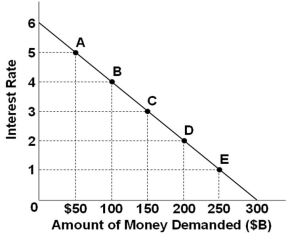 Refer to the graph above. If the supply of money was $200 billion, the interest rate would be:
Refer to the graph above. If the supply of money was $200 billion, the interest rate would be:A) 1 percent
B) 2 percent
C) 3 percent
D) 4 percent

Unlock Deck
Unlock for access to all 174 flashcards in this deck.
Unlock Deck
k this deck
33
When the interest rate falls, the:
A) Asset demand for money decreases
B) Transactions demand for money increases
C) Total amount of money demanded increases
D) Total amount of money demanded decreases
A) Asset demand for money decreases
B) Transactions demand for money increases
C) Total amount of money demanded increases
D) Total amount of money demanded decreases

Unlock Deck
Unlock for access to all 174 flashcards in this deck.
Unlock Deck
k this deck
34
In which case would the quantity of money demanded by the public tend to increase by the greatest amount?
A) The interest rate increases and nominal GDP increases
B) The interest rate increases and nominal GDP decreases
C) The interest rate decreases and nominal GDP decreases
D) The interest rate decreases and nominal GDP increases
A) The interest rate increases and nominal GDP increases
B) The interest rate increases and nominal GDP decreases
C) The interest rate decreases and nominal GDP decreases
D) The interest rate decreases and nominal GDP increases

Unlock Deck
Unlock for access to all 174 flashcards in this deck.
Unlock Deck
k this deck
35
Assume that the stock of money is determined by the Federal Reserve and does not change when the interest rate changes. This situation means that the:
A) Supply of money curve is vertical
B) Supply of money curve is horizontal
C) Demand for money curve is directly related to the interest rate
D) Supply of money curve is inversely related to the interest rate
A) Supply of money curve is vertical
B) Supply of money curve is horizontal
C) Demand for money curve is directly related to the interest rate
D) Supply of money curve is inversely related to the interest rate

Unlock Deck
Unlock for access to all 174 flashcards in this deck.
Unlock Deck
k this deck
36
Commercial bank reserves, most of which are held by the Federal Reserve Banks, are:
A) A liability of the Federal Reserve Banks and commercial banks
B) An asset of the Federal Reserve Banks and commercial banks
C) A liability of the Federal Reserve Banks and an asset for commercial banks
D) An asset of the Federal Reserve Banks and a liability for commercial banks
A) A liability of the Federal Reserve Banks and commercial banks
B) An asset of the Federal Reserve Banks and commercial banks
C) A liability of the Federal Reserve Banks and an asset for commercial banks
D) An asset of the Federal Reserve Banks and a liability for commercial banks

Unlock Deck
Unlock for access to all 174 flashcards in this deck.
Unlock Deck
k this deck
37
Typically the largest asset item in the Federal Reserve Banks' consolidated balance sheet (as illustrated in the book, for April 2013) is:
A) Loans to commercial banks
B) Federal Reserve Notes
C) Treasury deposits
D) Securities
A) Loans to commercial banks
B) Federal Reserve Notes
C) Treasury deposits
D) Securities

Unlock Deck
Unlock for access to all 174 flashcards in this deck.
Unlock Deck
k this deck
38
When the interest rate in the economy was 10%, the price of a bond with no expiration date and pays a fixed annual interest of $500 was $5,000. If the interest rate in the economy falls to 6%, the price of this bond will be about:
A) $4,700
B) $5,030
C) $7,128
D) $8,333
A) $4,700
B) $5,030
C) $7,128
D) $8,333

Unlock Deck
Unlock for access to all 174 flashcards in this deck.
Unlock Deck
k this deck
39
A bond with no expiration date has a face value of $10,000 and pays a fixed 10 percent interest. If the market price of the bond rises to $11,000, the annual yield approximately equals:
A) 11 percent
B) 10 percent
C) 9 percent
D) 8 percent
A) 11 percent
B) 10 percent
C) 9 percent
D) 8 percent

Unlock Deck
Unlock for access to all 174 flashcards in this deck.
Unlock Deck
k this deck
40
Disequilibrium in the money market is mainly corrected via a change in:
A) Bond prices
B) The price level
C) Saving levels
D) The money supply
A) Bond prices
B) The price level
C) Saving levels
D) The money supply

Unlock Deck
Unlock for access to all 174 flashcards in this deck.
Unlock Deck
k this deck
41
The interest rate that the Fed charges banks for loans to them through the traditional channel is called:
A) The discount rate
B) Interest on reserves
C) The federal funds rate
D) The prime rate
A) The discount rate
B) Interest on reserves
C) The federal funds rate
D) The prime rate

Unlock Deck
Unlock for access to all 174 flashcards in this deck.
Unlock Deck
k this deck
42
The fundamental objective of monetary policy is to assist the economy in achieving:
A) A rapid pace of economic growth
B) A money supply which is based on the gold standard
C) A full-employment, noninflationary level of total output
D) A balanced-budget consistent with full-employment
A) A rapid pace of economic growth
B) A money supply which is based on the gold standard
C) A full-employment, noninflationary level of total output
D) A balanced-budget consistent with full-employment

Unlock Deck
Unlock for access to all 174 flashcards in this deck.
Unlock Deck
k this deck
43
The Federal Reserve alters the amount of the nation's money supply by:
A) Reducing the liabilities of the banking system
B) Controlling the assets of the nation's largest banks
C) Minting coins and printing currency that is distributed to banks
D) Manipulating the size of excess reserves held by commercial banks
A) Reducing the liabilities of the banking system
B) Controlling the assets of the nation's largest banks
C) Minting coins and printing currency that is distributed to banks
D) Manipulating the size of excess reserves held by commercial banks

Unlock Deck
Unlock for access to all 174 flashcards in this deck.
Unlock Deck
k this deck
44
The purchase and sale of government securities by the Fed is called:
A) Federal funds market
B) Open market operations
C) Money market transactions
D) Term auction facility
A) Federal funds market
B) Open market operations
C) Money market transactions
D) Term auction facility

Unlock Deck
Unlock for access to all 174 flashcards in this deck.
Unlock Deck
k this deck
45
Answer the question based on the information given in the table below that shows the items and figures taken from a consolidated balance sheet of the twelve Federal Reserve Banks. All figures are in billions of dollars. 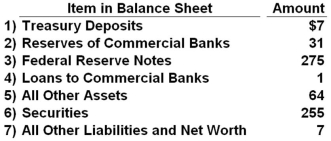 In the balance sheet above for the Federal Reserve, the liabilities and net worth would be items 7 and:
In the balance sheet above for the Federal Reserve, the liabilities and net worth would be items 7 and:
A) 1, 3, and 5
B) 2, 4, and 5
C) 1, 2, and 3
D) 4, 5, and 6
 In the balance sheet above for the Federal Reserve, the liabilities and net worth would be items 7 and:
In the balance sheet above for the Federal Reserve, the liabilities and net worth would be items 7 and:A) 1, 3, and 5
B) 2, 4, and 5
C) 1, 2, and 3
D) 4, 5, and 6

Unlock Deck
Unlock for access to all 174 flashcards in this deck.
Unlock Deck
k this deck
46
Answer the question based on the information given in the table below that shows the items and figures taken from a consolidated balance sheet of the twelve Federal Reserve Banks. All figures are in billions of dollars. 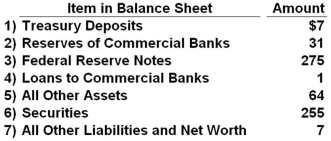 In the balance sheet above for the Federal Reserve, there would be assets of:
In the balance sheet above for the Federal Reserve, there would be assets of:
A) $246 billion
B) $313 billion
C) $320 billion
D) $387 billion
 In the balance sheet above for the Federal Reserve, there would be assets of:
In the balance sheet above for the Federal Reserve, there would be assets of:A) $246 billion
B) $313 billion
C) $320 billion
D) $387 billion

Unlock Deck
Unlock for access to all 174 flashcards in this deck.
Unlock Deck
k this deck
47
Assume that there is a 25 percent reserve ratio and that the Federal Reserve buys $200 million worth of government securities. If the securities are purchased from the public, then this action has the potential to increase bank lending by a maximum of:
A) $600 million, and also by $600 million if the securities are purchased directly from commercial banks
B) $800 million, and also by $800 million if the securities are purchased directly from commercial banks
C) $600 million, but by $800 million if the securities are purchased directly from commercial banks
D) $800 million, but only by $600 million if the securities are purchased directly from commercial banks
A) $600 million, and also by $600 million if the securities are purchased directly from commercial banks
B) $800 million, and also by $800 million if the securities are purchased directly from commercial banks
C) $600 million, but by $800 million if the securities are purchased directly from commercial banks
D) $800 million, but only by $600 million if the securities are purchased directly from commercial banks

Unlock Deck
Unlock for access to all 174 flashcards in this deck.
Unlock Deck
k this deck
48
Answer the question based on the information given in the table below that shows the items and figures taken from a consolidated balance sheet of the twelve Federal Reserve Banks. All figures are in billions of dollars. 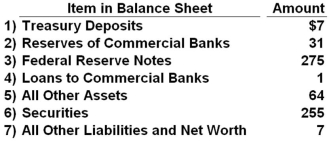 In the balance sheet above for the Federal Reserve, the assets would be items 5 and:
In the balance sheet above for the Federal Reserve, the assets would be items 5 and:
A) 1 and 2
B) 2 and 3
C) 3 and 4
D) 4 and 6
 In the balance sheet above for the Federal Reserve, the assets would be items 5 and:
In the balance sheet above for the Federal Reserve, the assets would be items 5 and:A) 1 and 2
B) 2 and 3
C) 3 and 4
D) 4 and 6

Unlock Deck
Unlock for access to all 174 flashcards in this deck.
Unlock Deck
k this deck
49
The lending ability of commercial banks increases when the:
A) Reserve ratio is raised
B) Treasury collects tax revenues
C) Fed sells securities in the open market
D) Fed buys securities in the open market
A) Reserve ratio is raised
B) Treasury collects tax revenues
C) Fed sells securities in the open market
D) Fed buys securities in the open market

Unlock Deck
Unlock for access to all 174 flashcards in this deck.
Unlock Deck
k this deck
50
The major purpose of the Federal Reserve buying government securities in open market operations is to:
A) Increase interest rates
B) Raise money for government spending
C) Reduce the excess reserves of banks
D) Allow banks to increase their lending
A) Increase interest rates
B) Raise money for government spending
C) Reduce the excess reserves of banks
D) Allow banks to increase their lending

Unlock Deck
Unlock for access to all 174 flashcards in this deck.
Unlock Deck
k this deck
51
Which of the following statements is correct?
A) Excess reserves may be found by subtracting actual from required reserves
B) The supply of money declines when the public purchases securities from commercial banks
C) Commercial bank reserves are a liability to commercial banks but an asset to Federal Reserve Banks
D) Commercial banks reduce the supply of money when they purchase government bonds from the public
A) Excess reserves may be found by subtracting actual from required reserves
B) The supply of money declines when the public purchases securities from commercial banks
C) Commercial bank reserves are a liability to commercial banks but an asset to Federal Reserve Banks
D) Commercial banks reduce the supply of money when they purchase government bonds from the public

Unlock Deck
Unlock for access to all 174 flashcards in this deck.
Unlock Deck
k this deck
52
If the Fed sells government securities to the general public in the open market:
A) The Fed gives the securities to the public; the public pays for the securities by writing checks that when cleared will increase commercial bank reserves at the Fed
B) The Fed gives the securities to the public; the public pays for the securities by writing checks that when cleared will decrease commercial bank reserves at the Fed
C) The public gives the securities to the Fed in exchange for a Fed check, which when deposited at commercial banks will increase their reserves at the Fed
D) The public gives the securities to the Fed in exchange for a Fed check, which when deposited at commercial banks will decrease their reserves at the Fed
A) The Fed gives the securities to the public; the public pays for the securities by writing checks that when cleared will increase commercial bank reserves at the Fed
B) The Fed gives the securities to the public; the public pays for the securities by writing checks that when cleared will decrease commercial bank reserves at the Fed
C) The public gives the securities to the Fed in exchange for a Fed check, which when deposited at commercial banks will increase their reserves at the Fed
D) The public gives the securities to the Fed in exchange for a Fed check, which when deposited at commercial banks will decrease their reserves at the Fed

Unlock Deck
Unlock for access to all 174 flashcards in this deck.
Unlock Deck
k this deck
53
The conduct of monetary policy in the United States is the main responsibility of the:
A) U.S. Treasury
B) Federal Reserve System
C) Office of Management and Budget
D) Bureau of Economic Analysis
A) U.S. Treasury
B) Federal Reserve System
C) Office of Management and Budget
D) Bureau of Economic Analysis

Unlock Deck
Unlock for access to all 174 flashcards in this deck.
Unlock Deck
k this deck
54
Which of the following Fed actions increases the excess reserves of commercial banks?
A) Selling bonds to the public
B) Selling bonds to commercial banks
C) Increasing the discount rate
D) Lower the reserve ratio
A) Selling bonds to the public
B) Selling bonds to commercial banks
C) Increasing the discount rate
D) Lower the reserve ratio

Unlock Deck
Unlock for access to all 174 flashcards in this deck.
Unlock Deck
k this deck
55
The Federal Reserve could reduce the money supply by:
A) Lowering the required reserve ratio
B) Buying government bonds in the open market
C) Increasing the interest on reserves
D) Reducing the discount rate
A) Lowering the required reserve ratio
B) Buying government bonds in the open market
C) Increasing the interest on reserves
D) Reducing the discount rate

Unlock Deck
Unlock for access to all 174 flashcards in this deck.
Unlock Deck
k this deck
56
Assume that there is a 25 percent reserve ratio and that the Federal Reserve buys $4 billion worth of government securities. If the securities are purchased from the non-bank public, this action has the potential to increase money supply by a maximum of:
A) $16 billion, but only by $14 billion if the securities are purchased directly from commercial banks
B) $14 billion, but by $16 billion if the securities are purchased directly from commercial banks
C) $16 billion, and also by $16 billion if the securities are purchased directly from commercial banks
D) $14 billion, and by $20 billion if the securities are purchased directly from commercial banks
A) $16 billion, but only by $14 billion if the securities are purchased directly from commercial banks
B) $14 billion, but by $16 billion if the securities are purchased directly from commercial banks
C) $16 billion, and also by $16 billion if the securities are purchased directly from commercial banks
D) $14 billion, and by $20 billion if the securities are purchased directly from commercial banks

Unlock Deck
Unlock for access to all 174 flashcards in this deck.
Unlock Deck
k this deck
57
The main tools that the Fed can use to alter the reserves of commercial banks are the required-reserve ratio and the following, except:
A) Exchange rate
B) Discount rate
C) Interest on reserves
D) Open market operations
A) Exchange rate
B) Discount rate
C) Interest on reserves
D) Open market operations

Unlock Deck
Unlock for access to all 174 flashcards in this deck.
Unlock Deck
k this deck
58
The largest liability item in the Federal Reserve Banks' consolidated balance sheet (as illustrated in the book, for April 2013) is:
A) Treasury deposits
B) Federal Reserve Notes
C) Reserves of commercial banks
D) Loans to commercial banks
A) Treasury deposits
B) Federal Reserve Notes
C) Reserves of commercial banks
D) Loans to commercial banks

Unlock Deck
Unlock for access to all 174 flashcards in this deck.
Unlock Deck
k this deck
59
Which one of the following is a tool of monetary policy often used by the Fed for altering the reserves of commercial banks?
A) Issuing currency
B) Check collection
C) Open-market operations
D) Required reserve ratio
A) Issuing currency
B) Check collection
C) Open-market operations
D) Required reserve ratio

Unlock Deck
Unlock for access to all 174 flashcards in this deck.
Unlock Deck
k this deck
60
If the Fed buys government securities from commercial banks in the open market:
A) The Fed gives the securities to the commercial banks and increases the banks' reserves
B) The Fed gives the securities to the commercial banks decreases the banks' reserves
C) Commercial banks give the securities to the Fed, and the Fed increases the banks' reserves
D) Commercial banks give the securities to the Fed, and the Fed decreases the banks' reserves
A) The Fed gives the securities to the commercial banks and increases the banks' reserves
B) The Fed gives the securities to the commercial banks decreases the banks' reserves
C) Commercial banks give the securities to the Fed, and the Fed increases the banks' reserves
D) Commercial banks give the securities to the Fed, and the Fed decreases the banks' reserves

Unlock Deck
Unlock for access to all 174 flashcards in this deck.
Unlock Deck
k this deck
61
Lowering the reserve ratio:
A) Increases the total reserves in the banking system
B) Also reduces the discount rate
C) Turns required reserves into excess reserves
D) Reduces the amount of excess reserves the banks keep
A) Increases the total reserves in the banking system
B) Also reduces the discount rate
C) Turns required reserves into excess reserves
D) Reduces the amount of excess reserves the banks keep

Unlock Deck
Unlock for access to all 174 flashcards in this deck.
Unlock Deck
k this deck
62
The interest rate that banks charge one another for the loan of excess reserves is the:
A) Prime interest rate
B) Federal funds rate
C) Discount rate
D) Interest on reserves
A) Prime interest rate
B) Federal funds rate
C) Discount rate
D) Interest on reserves

Unlock Deck
Unlock for access to all 174 flashcards in this deck.
Unlock Deck
k this deck
63
Assuming that the Federal Reserve Banks sell $40 million in government securities to commercial banks and the reserve ratio is 20 percent, then the effect will be to reduce:
A) Excess reserves by $8 million
B) Excess reserves by $200 million
C) The money supply by potentially $200 million
D) The money supply by potentially $400 million
A) Excess reserves by $8 million
B) Excess reserves by $200 million
C) The money supply by potentially $200 million
D) The money supply by potentially $400 million

Unlock Deck
Unlock for access to all 174 flashcards in this deck.
Unlock Deck
k this deck
64
Traditionally, the Fed often communicated its intentions to restrict or expand monetary policy by announcing a change in its target for the:
A) Prime rate
B) Federal funds rate
C) Discount rate
D) Consumer price index
A) Prime rate
B) Federal funds rate
C) Discount rate
D) Consumer price index

Unlock Deck
Unlock for access to all 174 flashcards in this deck.
Unlock Deck
k this deck
65
Assume that the required reserve ratio is 25 percent. If the Federal Reserve sells $120 million in government securities to the general public, the money supply will immediately:
A) Decrease by $120 million with this transaction, and the decrease in money supply could eventually reach a maximum of $480 million
B) Decrease by $120 million with this transaction, and the decrease in money supply could eventually reach a maximum of $360 million
C) Increase by $120 million with this transaction, and the increase in money supply could eventually reach a maximum of $480 million
D) Increase by $120 million with this transaction, and the increase in money supply could eventually reach a maximum of $360 million
A) Decrease by $120 million with this transaction, and the decrease in money supply could eventually reach a maximum of $480 million
B) Decrease by $120 million with this transaction, and the decrease in money supply could eventually reach a maximum of $360 million
C) Increase by $120 million with this transaction, and the increase in money supply could eventually reach a maximum of $480 million
D) Increase by $120 million with this transaction, and the increase in money supply could eventually reach a maximum of $360 million

Unlock Deck
Unlock for access to all 174 flashcards in this deck.
Unlock Deck
k this deck
66
If the Fed buys $1 million in government securities from Bank A, then the immediate effect of this transaction is an increase in:
A) Money supply M1
B) Bank A's excess reserves
C) Bank A's liabilities
D) Bank A's required reserves
A) Money supply M1
B) Bank A's excess reserves
C) Bank A's liabilities
D) Bank A's required reserves

Unlock Deck
Unlock for access to all 174 flashcards in this deck.
Unlock Deck
k this deck
67
The most recently-introduced tool of monetary policy is the:
A) Open-market operation
B) Discount rate
C) Interest on reserves
D) Reserve ratio
A) Open-market operation
B) Discount rate
C) Interest on reserves
D) Reserve ratio

Unlock Deck
Unlock for access to all 174 flashcards in this deck.
Unlock Deck
k this deck
68
In a supply-and-demand graph for the Federal funds market, the demand curve is downward-sloping because:
A) Higher rates give banks less incentive to lend to other banks
B) Higher rates give banks more incentive to borrow reserves
C) Lower rate give banks less incentive to borrow reserves
D) Lower rates give banks more incentive to borrow reserves
A) Higher rates give banks less incentive to lend to other banks
B) Higher rates give banks more incentive to borrow reserves
C) Lower rate give banks less incentive to borrow reserves
D) Lower rates give banks more incentive to borrow reserves

Unlock Deck
Unlock for access to all 174 flashcards in this deck.
Unlock Deck
k this deck
69
Lowering the discount rate has the effect of:
A) Turning required into excess reserves
B) Turning excess into required reserves
C) Making it less expensive for commercial banks to borrow from central banks
D) Forcing commercial banks to call in outstanding loans from their best customers
A) Turning required into excess reserves
B) Turning excess into required reserves
C) Making it less expensive for commercial banks to borrow from central banks
D) Forcing commercial banks to call in outstanding loans from their best customers

Unlock Deck
Unlock for access to all 174 flashcards in this deck.
Unlock Deck
k this deck
70
Assume that the required reserve ratio for the commercial banks is 25 percent. If the Federal Reserve Banks buy $3 billion in government securities from the non-bank securities dealers, then as a result of this transaction, the lending ability of the commercial banking system will increase by:
A) $4.5 billion
B) $9 billion
C) $12 billion
D) $15 billion
A) $4.5 billion
B) $9 billion
C) $12 billion
D) $15 billion

Unlock Deck
Unlock for access to all 174 flashcards in this deck.
Unlock Deck
k this deck
71
Assume that the required reserve ratio is 20 percent. If the Federal Reserve buys $80 million in government securities from the general public, then the money supply will immediately:
A) Increase by $0 with this transaction, and the maximum money-lending potential of the commercial banking system will increase by $400 million
B) Increase by $0 with this transaction, but the maximum money-lending potential of the commercial banking system will increase by $320 million
C) Increase by $80 million with this transaction, and the maximum money-lending potential of the commercial banking system will increase by another $400 million
D) Increase by $80 million with this transaction, and the maximum money-lending potential of the commercial banking system will increase by another $320 million
A) Increase by $0 with this transaction, and the maximum money-lending potential of the commercial banking system will increase by $400 million
B) Increase by $0 with this transaction, but the maximum money-lending potential of the commercial banking system will increase by $320 million
C) Increase by $80 million with this transaction, and the maximum money-lending potential of the commercial banking system will increase by another $400 million
D) Increase by $80 million with this transaction, and the maximum money-lending potential of the commercial banking system will increase by another $320 million

Unlock Deck
Unlock for access to all 174 flashcards in this deck.
Unlock Deck
k this deck
72
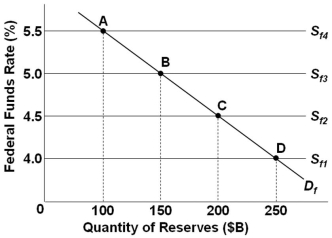 Refer to the figure above. If the Federal funds market is at equilibrium at point C and the Federal Reserve decides to conduct an open-market sale, then it must be trying to set a:
Refer to the figure above. If the Federal funds market is at equilibrium at point C and the Federal Reserve decides to conduct an open-market sale, then it must be trying to set a:A) Higher target federal funds rate by increasing the amount of reserves in the market
B) Higher target federal funds rate by reducing the amount of reserves in the market
C) Lower target federal funds rate by increasing the amount of reserves in the market
D) Lower target federal funds rate by reducing the amount of reserves in the market

Unlock Deck
Unlock for access to all 174 flashcards in this deck.
Unlock Deck
k this deck
73
Assume that the required reserve ratio is 20 percent. If the Federal Reserve buys $80 million in government securities from commercial banks, then the money supply will immediately:
A) Increase by $0 with this transaction, and the maximum money-lending potential of the commercial banking system will increase by $400 million
B) Increase by $0 with this transaction, but the maximum money-lending potential of the commercial banking system will increase by $320 million
C) Increase by $80 million with this transaction, and the maximum money-lending potential of the commercial banking system will increase by another $400 million
D) Increase by $80 million with this transaction, and the maximum money-lending potential of the commercial banking system will increase by another $320 million
A) Increase by $0 with this transaction, and the maximum money-lending potential of the commercial banking system will increase by $400 million
B) Increase by $0 with this transaction, but the maximum money-lending potential of the commercial banking system will increase by $320 million
C) Increase by $80 million with this transaction, and the maximum money-lending potential of the commercial banking system will increase by another $400 million
D) Increase by $80 million with this transaction, and the maximum money-lending potential of the commercial banking system will increase by another $320 million

Unlock Deck
Unlock for access to all 174 flashcards in this deck.
Unlock Deck
k this deck
74
What policy tool of the Federal Reserve relies on bank borrowing to be effective?
A) Open-market operations
B) Check collection
C) The reserve ratio
D) The discount rate
A) Open-market operations
B) Check collection
C) The reserve ratio
D) The discount rate

Unlock Deck
Unlock for access to all 174 flashcards in this deck.
Unlock Deck
k this deck
75
Raising the interest paid on reserves has the effect of making it:
A) More costly for banks to hold excess reserves
B) Less costly for banks to hold excess reserves
C) More attractive for banks to lend out their excess reserves
D) Less attractive for banks to hold required reserves
A) More costly for banks to hold excess reserves
B) Less costly for banks to hold excess reserves
C) More attractive for banks to lend out their excess reserves
D) Less attractive for banks to hold required reserves

Unlock Deck
Unlock for access to all 174 flashcards in this deck.
Unlock Deck
k this deck
76
Assume the commercial banking system has checkable deposits of $20 billion and excess reserves of $2 billion when the reserve ratio is 25 percent. If the reserve ratio is then lowered to 20 percent, we can conclude that the:
A) Banking system now has excess reserves of $3 billion
B) Monetary multiplier has decreased
C) Maximum money-creating potential of the banking system has been increased by $7 billion
D) Fed has decided that money supply needed to be reduced
A) Banking system now has excess reserves of $3 billion
B) Monetary multiplier has decreased
C) Maximum money-creating potential of the banking system has been increased by $7 billion
D) Fed has decided that money supply needed to be reduced

Unlock Deck
Unlock for access to all 174 flashcards in this deck.
Unlock Deck
k this deck
77
If the Fed reduces the interest paid on banks' reserves, it is trying to make banks hold:
A) More excess reserves
B) Less excess reserves
C) More required reserves
D) Less required reserves
A) More excess reserves
B) Less excess reserves
C) More required reserves
D) Less required reserves

Unlock Deck
Unlock for access to all 174 flashcards in this deck.
Unlock Deck
k this deck
78
The Fed can induce banks to increase their reserve holdings by:
A) Increasing the discount rate
B) Reducing the required reserve ratio
C) Increasing the interest on reserves
D) Selling securities in the open market
A) Increasing the discount rate
B) Reducing the required reserve ratio
C) Increasing the interest on reserves
D) Selling securities in the open market

Unlock Deck
Unlock for access to all 174 flashcards in this deck.
Unlock Deck
k this deck
79
If the Board of Governors of the Federal Reserve System increases the legal reserve ratio, this change will:
A) Increase the excess reserves of member banks and thus increase the money supply
B) Increase the excess reserves of member banks and thus decrease the money supply
C) Decrease the excess reserves of member banks and thus decrease the money supply
D) Decrease the excess reserves of member banks and thus increase the money supply
A) Increase the excess reserves of member banks and thus increase the money supply
B) Increase the excess reserves of member banks and thus decrease the money supply
C) Decrease the excess reserves of member banks and thus decrease the money supply
D) Decrease the excess reserves of member banks and thus increase the money supply

Unlock Deck
Unlock for access to all 174 flashcards in this deck.
Unlock Deck
k this deck
80
A television report states: "The Federal Reserve will lower the discount rate for the fourth time this year." This report indicates that the Federal Reserve is most likely trying to:
A) Reduce inflation
B) Save the banking industry
C) Stimulate the economy
D) Improve the savings rate
A) Reduce inflation
B) Save the banking industry
C) Stimulate the economy
D) Improve the savings rate

Unlock Deck
Unlock for access to all 174 flashcards in this deck.
Unlock Deck
k this deck



